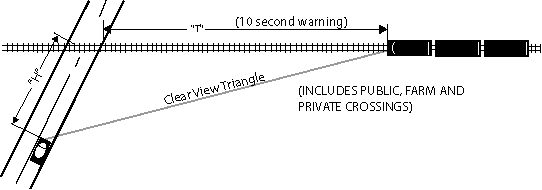| Maximum Speed (km/h) for vehicle | Distance* (H on above graph) | |
|---|---|---|
| Desirable (metres) | Minimum (metres) | |
| Stop | 8 | -- |
| 20 | 20 | 15 |
| 30 | 30 | 20 |
| 40 | 45 | 35 |
| 50 | 65 | 50 |
| 60 | 85 | 70 |
| 70 | 110 | 90 |
| 80 | 140 | 120 |
| 90 | 170 | 145 |
| 100 | 200 | 175 |
| Maximum Train Speed (m/h) | Minimum* Distance < |
|
|---|---|---|
| feet | (metres) | |
| Stop | 100 | (30) |
| 20 | 300 | (91) |
| 30 | 450 | (136) |
| 40 | 600 | (182) |
| 50 | 750 | (227) |
| 60 | 900 | (273) |
| 70 | 1050 | (318) |
| 80 | 1200 | (364) |
| 90 | 1350 | (409) |
| 100 | 1500 | (455) |
* To be increased as required by Notes 3 and 4 below.
To Establish Required Clear View Area
- Use maximum allowable train and vehicle speeds.
- View between 1.1 m above road (eye level) to track level.
- Where gradients within 8 m of rail exceed 5% or heavy or long vehicles regularly cross, clear view from a vehicle stopped at the crossing must also extend a minimum of 50% beyond "T", and more if necessary, so stopped vehicles have sufficient time to start up and cross safely.
- Where heavy vehicles operate on long descending approaches, increase "H" to 'stopping sight distances'.
- If clear view cannot be achieved for existing speeds, reduce speed of vehicles or trains until such time as an automatic warning system can be installed.
